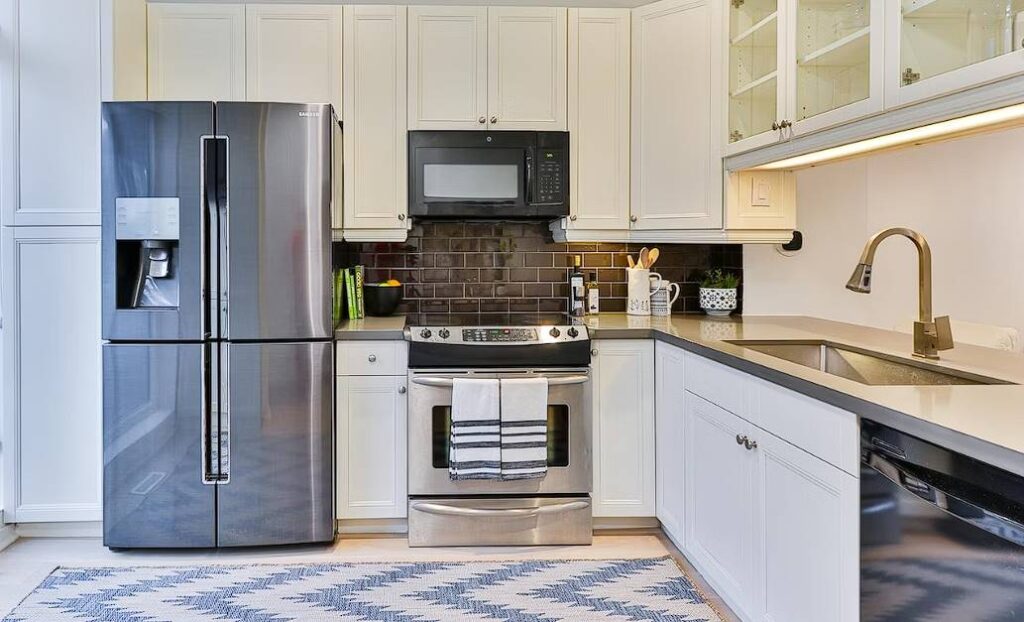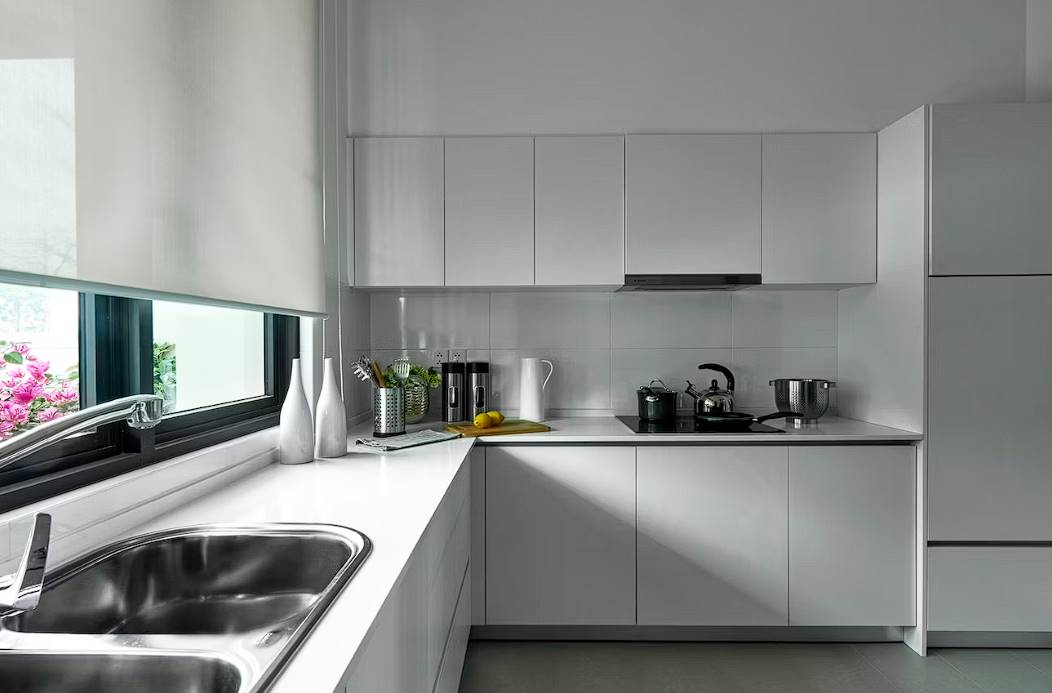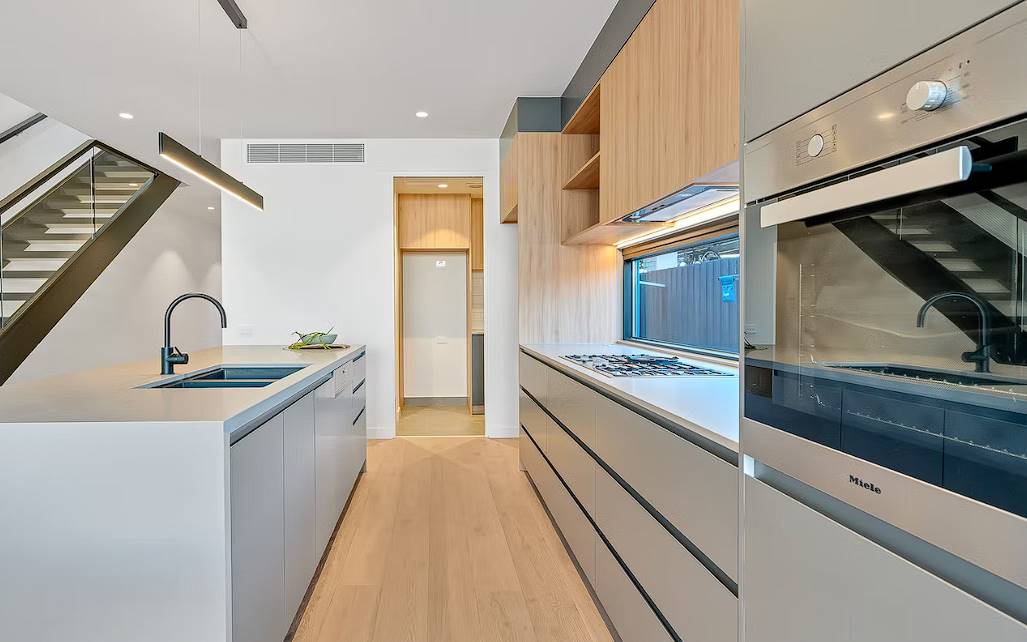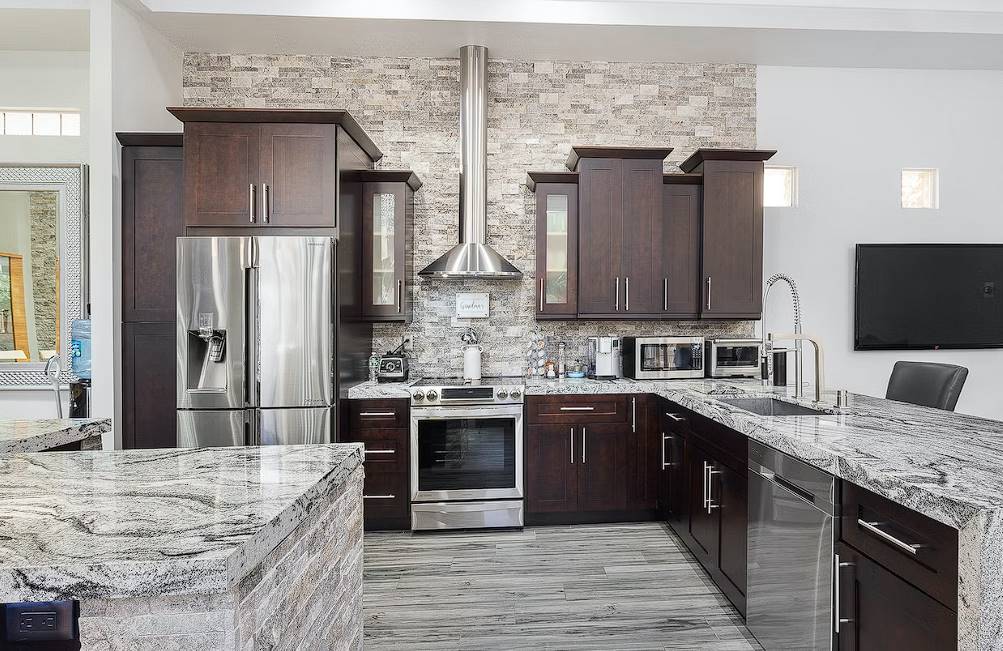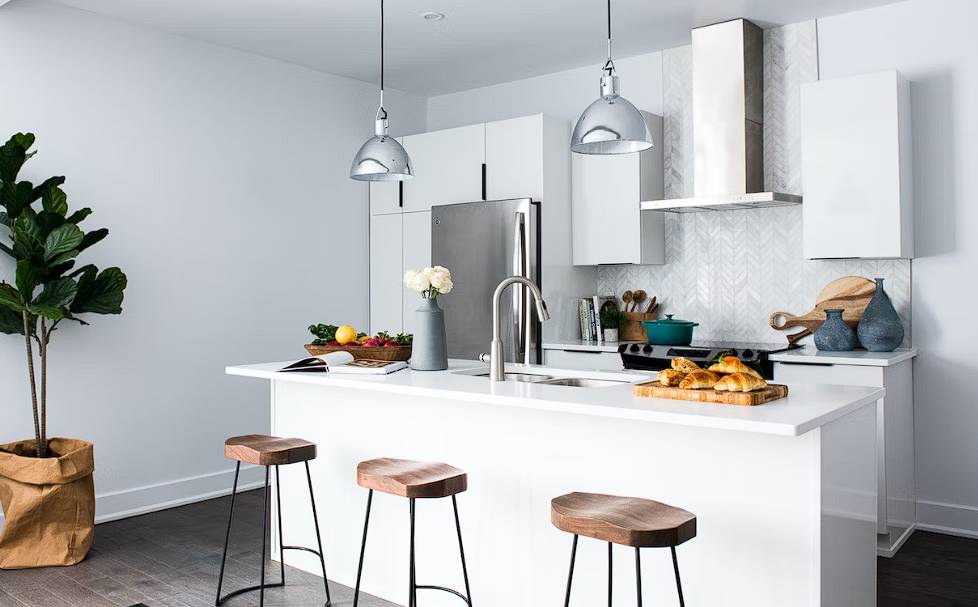Plywood boards and melamine are two popular materials for cabinet fixtures, as they are both inexpensive and widely used by homeowners. In addition, they are a great way to ensure that your cabinets blend in with the rest of the room because they are so adaptable and can be used in various variations (from a spare, modern aesthetic to a more rustic, traditional one based on wood).
Which of these woods, though, is best for use in kitchen cupboards? Both materials can do the job, so the decision is up to you, but plywood is easier to work with. While melamine boards have some benefits, plywood kitchen cabinet construction may be more durable in the long run.
Why Does The Material Of Your Kitchen Cabinets Matter?
The kitchen cabinet material you choose should serve two purposes: it should make your cabinets look nice and help keep your cabinets' contents in good condition. Manufacturers of cabinets will tell you that using the highest quality material for your cabinet boxes and doors will save you money and time in the long run. For example, plywood or melamine cabinets made to a high standard will look great in your home and last you for many years.
In light of the many uses to which the wood product you select may be put, including but not limited to cabinet boxes, cabinet doors, and cabinet fronts, the plywood or melamine you employ must be of the highest possible quality. They will complement your kitchen accessories while providing dimensional stability and durability.
What Is Melamine?
Melamine is a synthetic material that has many applications, including in the building and furniture industries, as well as kitchen cabinet manufacturing. A substrate, usually particleboard or medium-density fibreboard, is coated with melamine resin and paper is thermally fused to the surface (MDF). This production method results in a versatile, inexpensive material that is also durable and moisture-resistant material.
Melamine is versatile because it can be found in various colours, textures, and patterns. This makes it look like natural materials such as stone, wood, or other expensive options, but at a lower cost. Melamine is commonly used for kitchen cabinetry because of its longevity, scratch- and stain resistance, and low maintenance requirements.
Melamine's versatility means it can be used for anything from Formica laminate countertops to safeguarding laminated wood. However, if you are thinking about furnishing your kitchen with a melamine cabinet, there are two things you should keep in mind:
Overall Weight
Melamine is a composite material, meaning it is made up of various substances. If you use a lot of melamine boards in your kitchen cabinets, they may become too heavy to open without some additional support.
Melamine boards should only hold things as heavy as dishes or similar items. Over time, the weight can warp the boards, making the cabinet wobblier and potentially damaging the cabinet box if care is not taken.
Board Vs. Coating
While melamine boards are the standard when building kitchen cabinets, hardwood or plywood cabinets can have a melamine coating applied to improve their appearance. Whether your kitchen cabinets are made of board or coated wood depends on your taste and the advice of your cabinetmaker.
Melamine coatings are popular because they are durable, easy to clean, and can withstand high humidity and fluctuating temperatures in most kitchens. In addition, waterproof materials like plastic furniture boards can be used as a base for even better results.
The Advantages Of Melamine Cabinets
Melamine cabinets are widely used because of their many desirable features. However, its low price is the first and arguably greatest advantage of using melamine.
Affordability
Melamine cabinets' low cost is one of their main selling points. Melamine cabinets are less expensive than other options, such as solid wood or plywood. As a result, melamine is an excellent material for low-priced, high-quality kitchen cabinetry.
A Variety Of Designs
Today's melamine cabinets' styles, colours, textures, and finishes are practically limitless. Options exist for those who prefer a classic look and a more contemporary aesthetic. You can get the look you want for your kitchen by using melamine, which can simulate the look of natural wood grains, stone, and more.
Resistance To Water And Moisture
Melamine's water resistant is a lesser-known advantage, making it a great wood product. The melamine coating and glue give the compressed wood chips additional resistance to water. Melamine's resistance to moisture makes it a good material for frequently wet places.
Maintenance
Melamine's low maintenance is another reason why it's a good material for cabinets. While most routine cabinet maintenance consists of wiping them down, we all do it. This is also simplified since most melamine coatings are simple to wipe down.
Melamine cabinets are a good option, and you're right to think so. However, melamine storage units still need their share of drawbacks.
Appearance
Melamine's aesthetic value is a major pro and beats plywood in cost. Melamine's versatility comes from the material's many available colours and finishes.
Melamine, also known as particle board, gets its name from the numerous decorative coatings and colours available for it. Melamine's attractiveness is a major plus for these common cabinets, and the material's resistance to damage is an added bonus. Because of that, it is more resistant to wear and tear and damage from impacts.
The Disadvantages Of Melamine Cabinets
There are a few drawbacks to melamine cabinets, as there are to any product. Melamine's negatives centre primarily on the product's documented customer service issues.
Bad Reputation
It's important to note that melamine has a track record of customer complaints, even though several reasons are offered to explain this disadvantage. For example, it's been suggested that many homeowners and consumers have bought melamine cabinets thinking they were made of a different material.
Since melamine cabinets are so difficult to repair, this may be another factor contributing to their unfavourable reputation. However, the good news is that those who knowingly take melamine tend to have positive experiences with the substance.
Repair Options Are Limited
Melamine cabinets are more easily repaired than those made of natural wood. However, melamine's surface is less repairable than wood's, so if a cabinet is severely damaged, you might be better off replacing it.
Inadequate Authentic Wood Aesthetics
Melamine can be made to look like wood, but some people like the feel and look of real wood more. Melamine may need to meet your expectations if you want a more classic or high-end appearance.
Environmental Impact
Melamine, a synthetic material fabricated from resins and paper, can potentially harm the natural world. Compared to sustainable wood solutions, it may be less environmentally beneficial due to the usage of chemicals and energy in its production.
Chipping And Peeling Potential
Melamine cupboards may chip or peel at the edges and corners after some time has passed. Both impacts and excessive wear and tear can cause this. Therefore, careful use and avoidance of rough treatment are necessities when dealing with melamine cabinets.
What Is Plywood?
Plywood has long been the material of choice for cabinet boxes due to its adaptability and low cost. Since most kitchen cabinets require hardware like knobs, hinges, handles, and other fixtures to function properly, plywood's adaptability to these additions is arguably its greatest asset.
Plywood cabinets are favoured in most kitchen designs (and house designs in general) because of their timeless good looks and practicality. However, your kitchen design options will expand thanks to the variety of materials you can choose for your cabinet doors.
When working with plywood, it's important to remember the following:
Surface Finish
Plywood is a wood product, so your cabinets might not have the most appealing appearance at first. Wooden kitchen cabinets may need to be sanded or painted to hide grain, knots, and other flaws before installation. Plywood kitchen cabinets may require additional work unless their initial appearance suits your tastes.
Particularly if the cabinets are old and made of wood, which may be costly and time-consuming to replace, this could be a problem. To avoid damaging hardwood or plywood, disassemble the entire unit and replace just the damaged plywood or have a professional cabinet maker or refurbishment specialist work on your cabinets.
Density Of The Wood
Since plywood is not particularly dense, it can be shaped and altered to suit your needs. This allows for a wide variety of applications but also means it will only withstand significant force with reinforcement. If you want to store heavy objects in your kitchen cabinet or construct hanging cabinets, add extra support so you don't accidentally knock them down.
The low density also means minimal hardware and equipment are required for installation or hanging. In addition, plywood is easier to work with than other materials because it accepts standard screws and hinges with little effort.
The Advantages Of Plywood Cabinets
Plywood cabinets, like melamine ones, have some advantages and some drawbacks. Here we'll analyse the benefits and drawbacks of plywood to help you decide if it's the best material for your cabinets.
Improved Mounting
Plywood cabinets have greater screw and mounting strength than other options, partly because of the material's construction and inherent strength. As a result, plywood may be slightly heavier than other cabinet woods, but the difference is negligible, considering the material's mounting advantage.
Repairs
Cabinets made of plywood have the added benefit of being easy to fix if something goes wrong. Also, even though we hope we never have to use it, plywood is a much more manageable wood to work with than melamine in case of a cabinet door or corner breakage.
Durability And Strength
Plywood has a solid reputation for being long-lasting and sturdy. Plywood is a strong and reliable building material because it is constructed from multiple layers of wood veneers, with the grain direction of each layer running perpendicular to the next. As a result, unlike particle board or melamine, plywood cabinets are more durable and can handle greater weight before showing signs of wear.
Excellent Resistance To Moisture
When properly treated, plywood has a high tolerance for dampness and humidity. Because of this, it is a good option for kitchen cabinetry, which is frequently subjected to moisture and spills. In addition, plywood cabinetry can be protected from moisture and subsequent warping with regular sealing and maintenance.
Design Versatility
Plywood can be shaped and finished in a wide variety of ways. It's malleable, so you can modify it to fit your kitchen's specific dimensions and design. In addition, you can stain, paint, or leave raw plywood cabinets to show off their natural wood grains.
Natural Aesthetics
Plywood's inherent charm makes it a great material for cabinetry. Having natural wood grains and textures on display makes for a more inviting and sophisticated cooking space. Plywood's timeless beauty stems from its all-natural construction, making it an adaptable material for classic and contemporary settings.
The Disadvantages Of Plywood Cabinets
These are just a few drawbacks to each type of cabinet that may influence your final choice. In addition, these are things that customers and homeowners should know before purchasing new cabinets.
Moisture Concerns
Many homeowners favour plywood cabinets for high-moisture areas like the kitchen, but melamine has the upper hand when it comes to water and humidity resistance. That's why it's important for anyone planning to install cabinets in a damp environment, like a basement or a garage workshop, to take precautions.
Cost
Plywood cabinets are typically more expensive than their particleboard or melamine counterparts. The higher price is primarily attributable to the high-quality materials and labour put into building it. There might be better choices than plywood cabinets if you're trying to save money.
Scarring Easily
Plywood is sturdy and long-lasting than particleboard, but its real wood veneer easily scratches. It can also age if not cared for properly. As a result, plywood cabinets are commonly purchased unfinished for staining or painting.
Design Options Are Limited
Plywood's design flexibility is great, but it may only be suited to some aesthetic or every level of customisation. Plywood's natural aesthetics and visible wood grains may appeal to someone other than those looking for a more minimal and modern design. Plywood may not satisfy your aesthetic needs if you prefer a smooth surface or a high-gloss finish.
Potential For Formaldehyde Emissions
Formaldehyde is a VOC that can be discharged into the air and contribute to indoor air pollution, and it may be present in some lower-quality plywood. Therefore, to reduce the likelihood of health problems, you should use plywood that complies with all applicable regulations.
Insect And Pest Susceptibility
Insects and rodents can damage plywood cabinetry if improperly treated and sealed. In addition, plywood's wood fibres can attract pests because they provide a food source. Such problems can be avoided with timely maintenance and adequate safeguards.
Environmental Impact
Plywood is a renewable resource because it is made from wood; however, energy and chemicals are still used in manufacturing. Look for certifications from reputable groups to ensure that the plywood you buy comes from sustainably managed forests.
Conclusion
Plywood boards and melamine are two popular materials for kitchen cabinet fixtures, as they are both inexpensive and widely used by homeowners. Plywood is easier to work with and may be more durable in the long run. Melamine is a synthetic material that has many applications, including in the building and furniture industries, as well as kitchen cabinet manufacturing. Melamine is versatile because it can be found in various colours, textures, and patterns, making it look like natural materials at a lower cost. It is commonly used for kitchen cabinetry due to its longevity, scratch- and stain resistance, and low maintenance requirements.
Melamine is a versatile material that can be used for anything from Formica laminate countertops to safeguarding laminated wood. However, if you are thinking about furnishing your kitchen with a melamine cabinet, there are two things you should keep in mind: overall weight and board vs. coating. Melamine cabinets are widely used due to their many desirable features, such as their low price, affordability, variety of designs, resistance to water and moisture, and low maintenance. Melamine boards are the standard when building kitchen cabinets, while hardwood or plywood cabinets can have a melamine coating applied to improve their appearance. Advantages of melamine cabinets include their low cost, affordability, variety of designs, resistance to water and moisture, and low maintenance.
Melamine cabinets are a popular choice for storage units due to their aesthetic value, versatility, and resistance to damage. However, they have drawbacks such as documented customer service issues and a bad reputation due to their difficult to repair nature. Appearance is a major plus, but there are also drawbacks such as customer service issues and a bad reputation due to their difficult to repair nature. However, those who knowingly take melamine tend to have positive experiences with the substance. Melamine cabinets are more easily repaired than those made of natural wood, but their surface is less repairable than wood's.
They have an insufficient authentic wood aesthetic, environmental impact, and chipping and peeling potential. Plywood has long been the material of choice for cabinet boxes due to its adaptability and low cost. Plywood's adaptability to hardware like knobs, hinges, handles, and other fixtures is its greatest asset. Plywood cabinets are favoured in most kitchen designs due to their timeless good looks and practicality. However, it is important to remember the following when working with plywood: Surface Finish Plywood is a wood product, so it may need to be sanded or painted to hide grain, knots, and other flaws before installation.
Density Of The Wood Since plywood is not particularly dense, it can be shaped and altered to suit your needs, but it will only withstand significant force with reinforcement. If you want to store heavy objects in your kitchen cabinet or construct hanging cabinets, add extra support so you don't accidentally knock them down. Plywood cabinets, like melamine ones, have some advantages and drawbacks that can help homeowners decide if it's the best material for their cabinets. These include improved mounting strength, easy to fix if something goes wrong, durability and strength, excellent resistance to moisture, design versatility, natural aesthetics, potential for formaldehyde emissions, insect and pest susceptibility, and environmental impact. Plywood cabinets are typically more expensive than their particleboard or melamine counterparts due to the high-quality materials and labour put into building it.
Moisture concerns, cost, scarring easily, design options are limited, potential for formaldehyde emissions, insect and pest susceptibility, and environmental impact. Plywood is a renewable resource, but energy and chemicals are still used in manufacturing.
Content Summary:
- The kitchen cabinet material you choose should serve two purposes: it should make your cabinets look nice and help keep your cabinets' contents in good condition.
- Manufacturers of cabinets will tell you that using the highest quality material for your cabinet boxes and doors will save you money and time in the long run.
- For example, plywood or melamine cabinets made to a high standard will look great in your home and last you for many years.
- In light of the many uses to which the wood product you select may be put, including but not limited to cabinet boxes, cabinet doors, and cabinet fronts, the plywood or melamine you employ must be of the highest possible quality.
- If you use a lot of melamine boards in your kitchen cabinets, they may become too heavy to open without some additional support.
- Whether your kitchen cabinets are made of board or coated wood depends on your taste and the advice of your cabinetmaker.
- As a result, melamine is an excellent material for low-priced, high-quality kitchen cabinetry.
- Melamine cabinets are a good option, and you're right to think so.
- However, melamine storage units still need their share of drawbacks.
- Melamine's aesthetic value is a major pro and beats plywood in cost.
- Melamine's attractiveness is a major plus for these common cabinets, and the material's resistance to damage is an added bonus.
- There are a few drawbacks to melamine cabinets, as there are to any product.
- Melamine's negatives centre primarily on the product's documented customer service issues.
- It's important to note that melamine has a track record of customer complaints, even though several reasons are offered to explain this disadvantage.
- Since melamine cabinets are so difficult to repair, this may be another factor contributing to their unfavourable reputation.
- Melamine cabinets are more easily repaired than those made of natural wood.
- However, melamine's surface is less repairable than wood's, so if a cabinet is severely damaged, you might be better off replacing it.
- Melamine may need to meet your expectations if you want a more classic or high-end appearance.
- Both impacts and excessive wear and tear can cause this.
- Therefore, careful use and avoidance of rough treatment are necessities when dealing with melamine cabinets.
- Plywood has long been the material of choice for cabinet boxes due to its adaptability and low cost.
- However, your kitchen design options will expand thanks to the variety of materials you can choose for your cabinet doors.
- When working with plywood, it's important to remember the following: Surface Finish Plywood is a wood product, so your cabinets might not have the most appealing appearance at first.
- Particularly if the cabinets are old and made of wood, which may be costly and time-consuming to replace, this could be a problem.
- To avoid damaging hardwood or plywood, disassemble the entire unit and replace just the damaged plywood or have a professional cabinet maker or refurbishment specialist work on your cabinets.
- If you want to store heavy objects in your kitchen cabinet or construct hanging cabinets, add extra support so you don't accidentally knock them down.
- Plywood cabinets, like melamine ones, have some advantages and some drawbacks.
- Here we'll analyse the benefits and drawbacks of plywood to help you decide if it's the best material for your cabinets.
- Plywood cabinets have greater screw and mounting strength than other options, partly because of the material's construction and inherent strength.
Frequently Asked Questions
Cleaning your glasses daily is not mandatory, but it is highly recommended to prevent eye strain. Regular cleaning helps maintain optimal vision by removing dirt, oil, and smudges that accumulate on the lenses. By keeping your glasses clean, you ensure that your eyes can see through them clearly without the need for additional effort, reducing the risk of eye strain.
Keeping your glasses clean offers several additional benefits beyond preventing eye strain. Clean glasses provide clearer vision, enhancing your overall visual experience. Moreover, clean glasses reduce the risk of smudging your lenses or obstructing your view due to dirt and fingerprints. By maintaining clean glasses, you also extend the lifespan of the lens coatings and prevent potential damage that could compromise their functionality.
Yes, dirty glasses can worsen existing eye conditions. Individuals with conditions like astigmatism or nearsightedness rely on glasses to correct their vision. When these glasses are dirty, the visual correction they provide becomes compromised. The dirt or smudges on the lenses can amplify the existing vision problems, making it harder to see clearly and potentially exacerbating the symptoms associated with the condition.
Yes, dirty glasses can contribute to headaches and eye pain. When you wear glasses with smudges or dirt, your eyes may have to strain to compensate for the reduced clarity. This constant effort can lead to eye muscle fatigue and tension, which can trigger headaches. Additionally, the strain on your eyes can cause discomfort and pain in and around the eye area.
When cleaning glasses, it's best to use a mild soap specifically formulated for eyewear or a lens cleaning solution. Avoid using harsh chemicals, ammonia-based cleaners, or abrasive materials as they can damage the lens coatings. To clean your glasses, gently rub the lenses with your fingertips or a soft, lint-free cloth in a circular motion. Rinse them thoroughly and pat dry with a clean microfiber cloth to avoid scratching the lenses.

